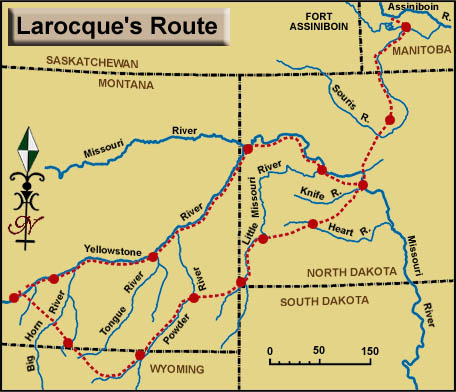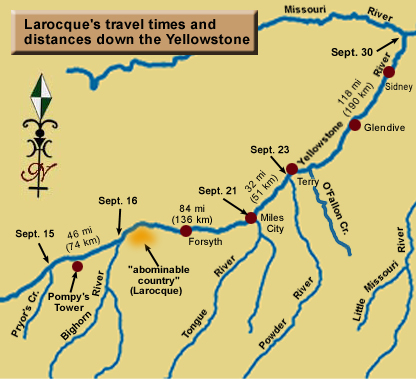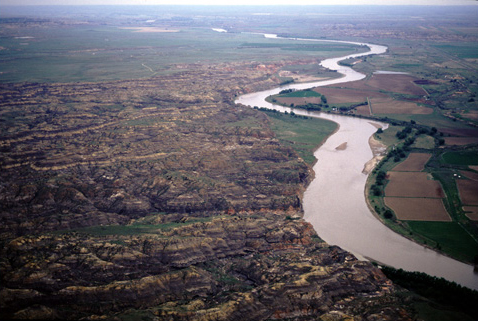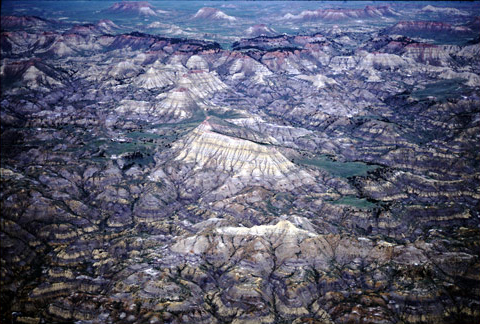Larocque’s Yellowstone Journey
After Wood and Thiessen[1]W. Raymond Wood and Thomas D. Thiessen, eds., Early Fur Trade on the Northern Plains: Canadian Traders Among the Mandan and Hidatsa Indians, 1738–1818 (Norman: University of Oklahoma Press, 1985), … Continue reading
François-Antoine Larocque left the Assiniboine River on 2 June 1805, arriving at the Knife River villages on 12 June 1805. In the company of a band of Crow Indians he reached the Yellowstone River near present-day Billings, Montana, on 10 September 1805. He returned to the Knife River Villages via Yellowstone and the Missouri on 9 October 1805, and was back at Fort Assiniboine at the mouth of the Souris on 27 October. The entire trip, covering more than 1,300 miles, lasted over four and one-half months.
Four months after arriving back at Fort Assiniboine in February—after a five-day dash through fierce winter storms and bitter cold temperatures—Larocque walked some 65 miles up the river from Fort Assiniboine, to Fort Montagne‚ à la Bosse (“Hump Mountain”). From there he set out with five men on 2 June, for “a voyage of discovery”—did he learn that turn of phrase from Lewis?—”to the Rocky Mountains.” His assignment was to visit the Crows in their homeland and determine whether reports of an abundance of beaver were true, and if so, to teach the Indians to trap them and preserve the pelts for the traders to come.
It was a dangerous assignment, and his boss, Charles Chaboillez, was duly concerned for his well-being. But after running a ten-day gauntlet of risks, from intimidating Assiniboine and Sioux Indians to spring storms and high rivers, he and his party reached the safety of the Mandan and Hidatsa villages on the Missouri, just five days after the Corps of Discovery had departed westward.[2]In their Estimate of Eastern Indians, Lewis and Clark characterized the Assiniboines as descendants of the Sioux who “partake of their turbulent and faithless disposition: they frequently … Continue reading Larocque immediately began making plans to proceed up the Yellowstone River to visit those “Rocky Mountain Indians,” the Crows.
Some of the Mandan and Hidatsa chiefs emphatically warned him against going, assigning “the worst character possible to the Rocky Mountain Indians, saying that they were thieves and liars,” and predicting he would almost certainly be killed by either Cheyennes or Arikaras. However, Chief Le Borgne, or “One Eye,” who generally favored British traders over Americans, set his mind at ease:
He answered to my wish, that the Rocky Mountains were good people, that they had plenty of Beavers on their hands, and that his adopted son, one of the Chiefs of the Rocky Mountains & the greatest would take care of us, for that he would strongly recommend to him to put the white people in his heart and watch over them.
Among the Crow Nation
Meanwhile, a band of Crows had arrived to trade with the Mandans and Hidatsas, and on 29 June 1805 Larocque and two companions, William Morrison and a man named Souci, joined the visitors on their homeward journey. They headed up the Knife for a short distance, then southwest across the upper Heart River, struck the Little Missouri a few miles south of today’s Medora, North Dakota, reached the Powder River at Powderville in southeastern Montana, followed the Powder to the vicinity of Sheridan, Wyoming, edged along the northeast flank of the Bighorn Mountains and past the Pryors, and arrived at the Yellowstone near today’s Billings on 13 September 1805.
Somewhere in southeastern Montana the Crows killed and butchered two enemy Indian scouts, with even women and children taking part in inflicting post-mortem indignities upon their wretched corpses. “The sight made me shudder with horror at such cruelties,” Larocque wrote, “and I returned home in quite a different frame from that in which I left it.” The celebratory scalp dances continued intermittently for several days. On the whole, however, Larocque’s descriptions of the landscape he traversed, and of the Crow people he traveled with, are richly detailed, and add much to our picture of that corner of the West at the beginning of the 19th century.
On 14 September 1805 Larocque took leave of his Indian hosts, promising to come back and trade with them for furs the following autumn. However, he did not, and in fact went home to Montreal in 1806, never to return to the West.
Prior to Clark’s 1806 Exploration
William Clark and his contingent of the Corps of Discovery explored the Yellowstone River from 15 July 1806 to 3 August 1806, from the Big Bend at today’s Livingston, Montana, to its mouth. The first white men to see any part of the Yellowstone River may have been the French explorers Louis and François La Vérendrye, who seem to have gotten within sight of the Bighorn Mountains in the summer of 1742 before abandoning their effort to find a waterway from eastern Canada to the Pacific Ocean. Next came Pierre Ménard, a French Canadian trader who claimed to have been on the Yellowstone sometime before 1795. Another trader by the name of Charles Le Raye is said to have traveled as far as the mouth of the Bighorn River in 1802, though there is some doubt about the authenticity of the report attributed to him.[3]A. P. Nasatir, ed., Before Lewis and Clark: Documents Illustrating the History of the Missouri, 1785–1804 (Bison Book edition, 1990; 2 vols., Lincoln: University of Nebraska Press, 1958), … Continue reading
Fourth in line was François-Antoine Larocque (1784–1869), who is important to the story of Lewis and Clark on the Middle Missouri for several reasons:
- He made two trips from Fort Assiniboine to the Mandan villages, in 1804 and 1805, and wrote concise descriptions of his experiences, although the purpose of his trips was essentially commercial. (He also wrote the first detailed ethnographic description of the Crow Indians and their culture, comparing them with the Mandans and Hidatsas.)
- On his first trip, in the fall of 1804, he met Lewis and Clark, and his journals, as well as those of his companion, Charles McKenzie, contain a unique slant on certain aspects of the expedition and its commanders.
- On his second trip he joined a group of homeward-bound Crow Indians at the Mandan villages, and arrived at the Yellowstone via the Mampoa, or Shot Stone River—which Clark was to call Pryor Creek—via a southern overland route, thereby preceding Clark on the Yellowstone by 10 months and 15 days.
- The account of his return trip down along the Yellowstone that fall, though containing some possible errors and a few obvious omissions, suggests what Nathaniel Pryor would have faced had he been ordered to follow the Yellowstone and Missouri to the Mandan villages.[4]François-Antoine Larocque’s “Missouri Journal” and “Yellowstone Journal” are in W. Raymond Wood and Thomas D. Thiessen, Early Fur Trade on the Northern Plains: Canadian … Continue reading [5]See also Pryor’s Mission.
Larocque’s “abominable” Return
Yellowstone Badlands
West of Terry, Montana (looking west)
© 2001 Airphoto, Jim Wark. All rights reserved.
Here Larocque had it easy, traveling on the southeast side (the viewer’s right) of the Yellowstone. The following summer (29 July 1806), Clark recorde his impression of the breaks on the northwest side: “The hills are high and ruged Containing Coal in great quantities.” That is all he could see of the stream-deposited, coal-bearing, extensively eroded sediments of the Paleocene Epoch (65–58 million years ago), in what geologists today call the Tullock member of the Fort Union Formation.
On 15 September 1805, Larocque and his two companions arrived at the landmark Clark was to name Pompy’s Tower. They pitched camp in the dark that night, “making no fire for fear of being discovered by horse thieves or enemies.” At 8:00 p.m. on the sixteenth, having covered thirty-seven miles, they reached the mouth of the Bighorn River.
17 September was one of the worst days in Larocque’s four and one-half month tour of Crow Country.
We passed through a most abominable Country and often despaired of being able to get clear of this place enceting [beset?] with Rocks which it was impossible to ascend or to go round, so we were obliged often to go back on other road which presented us with the same difficulties. At last we ascended the hill but being on the top did not offer a more pleasing prospect. We were often obliged to unload the horses and carry baggage ourselves, and the horses being light we made jump over chasms in the Rock and climb precipices, but were near losing them.
At last, at 3 in the afternoon, we passed the whole of that bad road and arrived at the Border of Rocks where we could see a fine level country before us. But the sun was set before we could find a practiable road to come down to it, which we effected not without unloading the horses and carrying down their loads part of the way, while the horses slided down upon their rumps about 25 yards.
It was dark before they reached the plain. Had they had an Indian guide, Larocque admitted, they could have avoided those badlands, but once they entered them it seemed as hard to return as to proceed. “We Kept no regular course,” he lamented, “but went on as we could to all points of the compass in order to extricate ourselves.” He estimated they covered only nine miles that day.
For fear of Indian attack, the three men usually walked until after dark, lit no evening campfires, and shared the nightwatch. There were days when grass was so scarce they fed their horses on cottonwood bark—when they could find any trees. They shod their footsore horses with raw deer hide, “as their hoofs are worn out to the flesh with continual walking since last Spring.” On 27 September 1805 they had to take to the riverbank to get around some rocks, but three of their horses became stuck in the mud. The farther down the Yellowstone, the traveling became easier; some days Larocque estimated they made nearly 40 miles. Or maybe it just seemed like 40 miles.
On 30 September 1805 they arrived at the confluence of the Yellowstone with the Missouri, having covered about 280 miles in 14 days, thus averaging about 20 miles per day—not counting the ups and downs. That was pretty good by 1805 standards, but Clark, on the water, would cover the same distance in just nine days, averaging a little over 36 miles per day. It was another 245 miles to the mouth of the Knife and the Mandan villages. Larocque covered that stretch in nine days, arriving overland on 9 October.
Commentary
Larocque’s narrative of his journey down the Yellowstone river in the early fall of 1805 is problematic at several points. He wrote that at about 10:00 a.m. on 15 September 1805, on the east side of Pryor’s Creek at its confluence with the Yellowstone, he passed “a whitish perpendicular Rock on which is painted with Red earth a battle between three persons on horseback and 3 on foot.” But there is no perpendicular rock at or near that location today, and no evidence there ever was one. At 2:00 p.m. the same day he arrived at “a high hill on the side of the river called by the natives “Erpian Macolié.” Whether or not this place was identical with the “remarkable rock” Clark was to call Pompy’s Tower cannot be known, but the latter does not fit today’s definition of hill—small heap or mound.” It is possible, even likely, that Larocque did indeed see an Indian pictograph near Pryor’s Creek,[6]In 1876 Lt. James Bradley, descending the Yellowstone from the vicinity of today’s Billings, Montana, observed: “At the point where the road ascends from the Clark’s Fork bottom, … Continue reading but we are disposed to conclude that he wrote these journal entries some time later, that he confused the two landmarks in his mind, and that the “whitish perpendicular Rock” he mentioned is actually Pompy’s Tower.
The following day, 16 September 1805, Larocque and his companions arrived at “the Rocks of the large Horn [Bighorn] River” at 8:00 p.m. On the seventeenth they passed through “a most abominable country and often despaired of being able to get clear of [the] place.” On the southeast side of the Yellowstone, beginning about four miles below the Bighorn, there is a five-mile stretch where the terrain is rough, to be sure, but not so much so as to evoke such plaints as he uttered on that single day. And there are nearly a dozen other places along the same side of the Yellowstone that would have been at least equally as difficult, though he mentions only one. Perhaps the explanation is that Larocque wrote of his Yellowstone journey some time after it was over, and that his recollections were imperfect—not surprising, considering all the new experiences he had undergone in a strange and danger-ridden land. Why he didn’t return by the route Sheheke had mapped for Clark (see Clark’s Fort Mandan Maps, “Sheheke’s Map”) can only be imagined.
Notes
| ↑1 | W. Raymond Wood and Thomas D. Thiessen, eds., Early Fur Trade on the Northern Plains: Canadian Traders Among the Mandan and Hidatsa Indians, 1738–1818 (Norman: University of Oklahoma Press, 1985), p. 161. |
|---|---|
| ↑2 | In their Estimate of Eastern Indians, Lewis and Clark characterized the Assiniboines as descendants of the Sioux who “partake of their turbulent and faithless disposition: they frequently plunder, and sometimes murder, their own traders.” They also reportedly were “great Drunkards.” They might be induced to come to a trading post at the mouth of the Yellowstone, wrote Lewis, “but I do not think that their trade promises much.” Thus, although the captains never met any Assiniboines face to face, they readily accepted the judgments of the Mandans and Hidatsas. See James Ronda, Lewis and Clark Among the Indians (Lincoln: University of Nebraska press, 1984), 202–03. |
| ↑3 | A. P. Nasatir, ed., Before Lewis and Clark: Documents Illustrating the History of the Missouri, 1785–1804 (Bison Book edition, 1990; 2 vols., Lincoln: University of Nebraska Press, 1958), 1:31–33, 110. |
| ↑4 | François-Antoine Larocque’s “Missouri Journal” and “Yellowstone Journal” are in W. Raymond Wood and Thomas D. Thiessen, Early Fur Trade on the Northern Plains: Canadian Traders Among the Mandan and Hidatsa Indians, 1738-1818 (Norman: University of Oklahoma Press, 1985), 133–220. Larocque’s journals were first published in an incomplete and inaccurate French edition in 1889-90. The edition by Wood and Thiessen is the first complete version in English. For a brief biography of Larocque, and the history of his journals, see pages 129-32. |
| ↑5 | See also Pryor’s Mission. |
| ↑6 | In 1876 Lt. James Bradley, descending the Yellowstone from the vicinity of today’s Billings, Montana, observed: “At the point where the road ascends from the Clark’s Fork bottom, the rocks are lavishly adorned with Indian hieroglyphics, some of them graven deeply in the face of the rock at a considerable height above the ground and in places difficult of access.” Journal of James H. Bradley, in Contributions to the Historical Society of Montana, Vol. II (Boston: J. S. Canner, 1966), 165. |
Experience the Lewis and Clark Trail
The Lewis and Clark Trail Experience—our sister site at lewisandclark.travel—connects the world to people and places on the Lewis and Clark Trail.
Discover More
- The Lewis and Clark Expedition: Day by Day by Gary E. Moulton (University of Nebraska Press, 2018). The story in prose, 14 May 1804–23 September 1806.
- The Lewis and Clark Journals: An American Epic of Discovery (abridged) by Gary E. Moulton (University of Nebraska Press, 2003). Selected journal excerpts, 14 May 1804–23 September 1806.
- The Lewis and Clark Journals. by Gary E. Moulton (University of Nebraska Press, 1983–2001). The complete story in 13 volumes.





